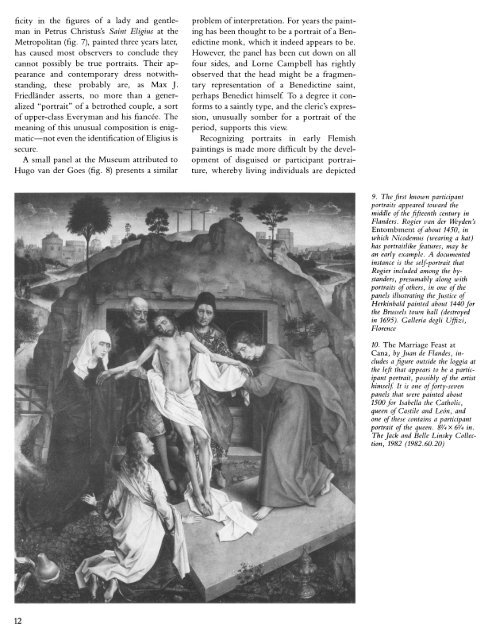Early Flemish Portraits 1425-1525: The Metropolitan Museum of Art ...
Early Flemish Portraits 1425-1525: The Metropolitan Museum of Art ...
Early Flemish Portraits 1425-1525: The Metropolitan Museum of Art ...
Create successful ePaper yourself
Turn your PDF publications into a flip-book with our unique Google optimized e-Paper software.
ficity in the figures <strong>of</strong> a lady and gentleman<br />
in Petrus Christus's Saint Eligius at the<br />
<strong>Metropolitan</strong> (fig. 7), painted three years later,<br />
has caused most observers to conclude they<br />
cannot possibly be true portraits. <strong>The</strong>ir appearance<br />
and contemporary dress notwithstanding,<br />
these probably are, as Max J.<br />
Friedlander asserts, no more than a generalized<br />
"portrait" <strong>of</strong> a betrothed couple, a sort<br />
<strong>of</strong> upper-class Everyman and his fiancee. <strong>The</strong><br />
meaning <strong>of</strong> this unusual composition is enigmatic-not<br />
even the identification <strong>of</strong> Eligius is<br />
secure.<br />
A small panel at the <strong>Museum</strong> attributed to<br />
Hugo van der Goes (fig. 8) presents a similar<br />
problem <strong>of</strong> interpretation. For years the painting<br />
has been thought to be a portrait <strong>of</strong> a Benedictine<br />
monk, which it indeed appears to be.<br />
However, the panel has been cut down on all<br />
four sides, and Lorne Campbell has rightly<br />
observed that the head might be a fragmentary<br />
representation <strong>of</strong> a Benedictine saint,<br />
perhaps Benedict himself To a degree it conforms<br />
to a saintly type, and the cleric's expression,<br />
unusually somber for a portrait <strong>of</strong> the<br />
period, supports this view.<br />
Recognizing portraits in early <strong>Flemish</strong><br />
paintings is made more difficult by the development<br />
<strong>of</strong> disguised or participant portraiture,<br />
whereby living individuals are depicted<br />
9. <strong>The</strong> first known participant<br />
portraits appeared toward the<br />
middle <strong>of</strong> the fifteenth century in<br />
Flanders. Rogier van der Weyden's<br />
Entombment <strong>of</strong> about 1450, in<br />
which Nicodemus (wearing a hat)<br />
has portraitlike features, may be<br />
an early example. A documented<br />
instance is the self-portrait that<br />
Rogier included among the bystanders,<br />
presumably along with<br />
portraits <strong>of</strong> others, in one <strong>of</strong> the<br />
panels illustrating the Justice <strong>of</strong><br />
Herkinbald painted about 1440 for<br />
the Brussels town hall (destroyed<br />
in 1695). Galleria degli Uffizi,<br />
Florence<br />
10. <strong>The</strong> Marriage Feast at<br />
Cana, by Juan de Flandes, includes<br />
a figure outside the loggia at<br />
the left that appears to be a participant<br />
portrait, possibly <strong>of</strong> the artist<br />
himself It is one <strong>of</strong>forty-seven<br />
panels that were painted about<br />
1500for Isabella the Catholic,<br />
queen <strong>of</strong> Castile and Leon, and<br />
one <strong>of</strong> these contains a participant<br />
portrait <strong>of</strong> the queen. 81/4 X 6/4 in.<br />
<strong>The</strong>Jack and Belle Linsky Collection,<br />
1982 (1982.60.20)

















